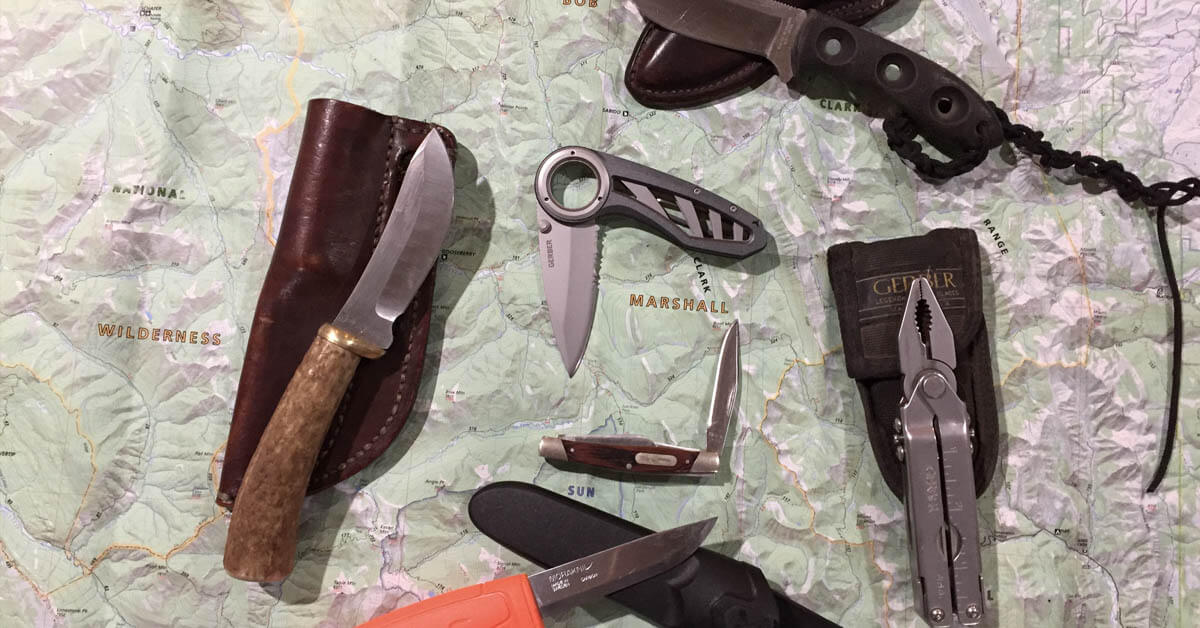I’m a big believer in every horseman having a sharp, easily accessible knife on them when they’re around stock. The knife is not just to cut baling twine, slice bacon, or whittle with when you’re bored. It can save lives—maybe yours.
Knives are one of the ten essentials every rider should carry on every ride. They are one of the first tools ever invented. Even though a trail ride isn’t typically a “survival” scenario, a knife is an essential tool when heading into the great outdoors—whether field or wilderness.
I recently asked followers of my Facebook page (www.facebook.com/TrailMeister) to be honest and share how they usually end up using their knife on a ride or camping trip. Here’s what they had to say:
Top Four Uses for a Knife
- Opening packets (of food)
- Repairs
- Making a spark (with a fire steel)
- Cutting rope in a wreck
Other than the wreck, these are pretty mundane uses. These are all normal reasons why we need a knife when we’re on the trail. And they’re all valid.
What Type of Knife?
I prefer a fixed blade knife that I carry on my belt. In an emergency, I can pull it out, not worry about opening a blade, and quickly handle whatever situation I’m in at the time. I like the blade to be about 3.5 to 4 inches long. Long enough to get to the bottom of the peanut butter jar!
There’s also a place for a folding knife. The cowboys of yore nearly all carried a folding pocketknife. Called stockman’s knives, they usually had three blades. You can still find these useful tools and I can usually find one in my pocket. You may not cut yourself out of a wreck with one, but for opening a bag of Fritos they’re perfect!
For quick repairs, a multi-tool calls my saddlebags home. One of the biggest pros of the multi-tool is undoubtedly the pliers. The entire tool is designed around these pliers. People wind up needing pliers a lot more than they think they will. Carrying them with you is a huge bonus.
Fixed Blade Benefits
- Simple to use
- No moving parts
- Less opportunity to cut yourself (Since there is no need to disengage a locking mechanism and fold the blade, there is less opportunity to accidentally cut yourself in the process)
- Easier to maintain
- Check out Fixed Blades on Amazon.com
Folding Knife Benefits
- No sheath required
- Stores more compactly
- Multi-use… If it’s a multi-tool, you’ll have additional gadgets beside the blade itself in one compact package
- Check out Folding Knives on Amazon.com
Serrated Blades
Ropes today are often made of nylon or polypropylene, which can be hard to cut with an ordinary or plain blade. So, the serrated blade, or a partially serrated blade, has become popular with many people. In general, the serrated edge works better for slicing cuts, especially through hard or tough surfaces, where the serrations tend to grab and cut the surface easily.
Slicing cuts: The cutting action is substantially done by dragging the edge across the thing-to-be-cut. When you slice a tomato, you drag the edge across the tomato as you cut through it. Slicing and sawing are examples of slicing cuts.
Check out Serrated Blades on Amazon.com
Plain Blades
In general, a plain edge is best when doing push cuts. Also, the plain edge is superior when control, accuracy, and clean cuts are necessary.
Push cuts: The main cutting is done by pushing the edge through the thing-to-be-cut. For example, when you shave, you push the edge of the knife through your beard. When peeling an apple, you push the edge under the skin of the apple. When chopping wood, you try to push the edge into and through the wood.
Well, there are my thoughts on knives. I feel naked when caught without a knife as it is the most basic of tools. I can cut baling twine, lash ropes, make a fire, among a million other uses. Heck, I even use my knife as a screwdriver at times. I urge you to find and carry a knife whenever you’re around horses and mules. You’ll wonder how you ever survived without one!
As always for more information on trail riding and camping with horses visit www.TrailMeister.com. It’s the largest guide to horse trails and camps in the world and is full of tips and tricks for trail riders.

Robert Eversole, ”the trail meister,” owns www.TrailMeister.com, the largest database of horse riding and camping areas in the U.S. with free trail and trailhead information, trail maps, and much more to help horse enthusiasts experience the joys of trail riding. Robert is a registered riding instructor with PATH International, a mounted search and rescue team member, and a U.S. Marine who has served on the board of the Backcountry Horsemen of Washington (BCHW). He is enjoying his new career helping fellow trail riders stay found and safe on the trail. When not on the trail, The Trail Meister resides near Spokane, WA and teaches land navigation to a wide variety of outdoor groups across the nation. For North America’s largest horse trail and camping directory, trail tips, and more, visit www.TrailMeister.com.






